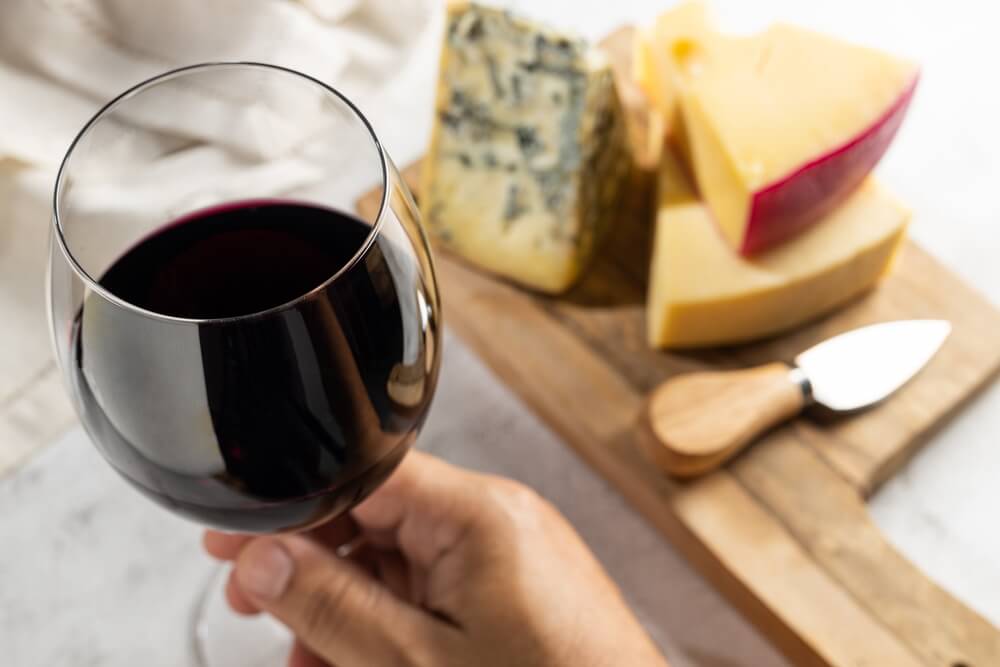There’s nothing more enjoyable than a relaxing night in with your family or friends. But, when it’s your turn to host, some of that joy can turn into stress. If you often find yourself stressed about how to keep your guests happy or what to serve with wine, you’re in the right place.
The good news is you don’t have to be an expert to host a crowd-pleasing evening. Keep things simple with a classic spread of cheese paired with some of your favorite wines. Learn how to impress your guests each time you host with this guide to wine and cheese pairings.

Why Wine & Cheese Are the Perfect Pair
What makes wine and cheese pairings so addicting? The old adage, opposites attract, can help explain. When it comes to taste, cheese and wine couldn’t be more different.
Wine is acidic and contains no fat, giving our taste buds a dry or bitter sensation upon tasting. Cheese is considerably less acidic and higher in fat, which creates a more delicate or smooth sensation.
When paired together, the differences in acidity and fat blend to create balance. Food scientists have actually discovered that when done right, enjoying them together enhances the taste experience.
General Tips for Wine and Cheese Pairings
Like all things, there are exceptions to the “rules” of pairing wine and cheese. However, there are 3 general rules of thumb that are considered the most important.
1. Consider the Age of Your Cheese & Wine
The maturity of the wine and cheese you select directly impacts its flavor, texture, and overall intensity.
Fresh, “young,” cheese has a high water content that results in a milky, delicate flavor and texture. As cheese ages, moisture evaporates while fats and proteins remain, producing a richer flavor.
Young wines contain aromas and flavors of fruits, flowers, citruses, and spices while older “aged” wines acquire additional depth of oak, earth, and mineral flavors.
In cheese and wine pairings, it’s best to match the intensity of the cheese with the intensity of the wine (or vice versa). This means serving young cheese with young wines like sparkling, crisp white, rosé, or fruity red wine.
Following that same logic, it makes sense to pair rich, aged cheese with older red wines which have more body and complexity in taste.
Ages of Cheese
Use the texture of the cheese to help determine its age:
- Soft, fresh cheese is the youngest.
- Semi-hard cheese is semi-mature.
- Hard, aged cheese is the oldest.
Examples of Cheese by Its Age:
- Young cheese — Mozzarella, burrata, feta, goat, brie, & Camembert
- Semi-mature cheese — Havarti, Gruyere, young cheddar, Monterey Jack, & Manchego
- Aged cheese — Aged cheddar, aged Gruyère, Pecorino, Asiago, & Parmigiano Reggiano

Ages of Wine
Use the color of the wine to help determine its age.
- Young white wines are light yellow. As they mature, the color intensifies.
- Aged white wine is a golden yellow.
- Young red wines are purple. As they age, they start to become a deep red.
- Aged red wine is red-brown.
If you can’t tell the color through the bottle, you should be able to see when the wine was bottled in its description. The chart below shows the appropriate time for wine to be bottled in order to be considered aged.
Examples of Wine by Its Age:
- Young White — Wines aged for less than 1-2 years.
- Aged White — Wines aged for over 2 years.
- Young Red — Wines aged for less than 5 years.
- Aged Red — Wines aged from 5-30 years (sometimes even longer).
2. Pair Sweet with Salty
Think about the perfect snack food and the wonderful combination of sweet and salty — chocolate-covered pretzels or caramel and cheddar popcorn. The same is true when it comes to your wine and cheese pairings.
Serve sweet wines with salty cheese, and dry wines with a smokey or spicy cheese.
According to this “Cheesemonger’s Guide To Cheese Tasting,” there are 5 main ways to identify the taste of cheese:
- Sweet — Goat cheese, burrata, or mascarpone
- Acidic — Mozzarella, ricotta, or gruyere
- Salty — Blue cheese, feta, or swiss
- Bitter — Gouda, cheddar, or provolone
- Savory (Umami) — Most aged cheeses; aged parmesan, gouda, or cheddar
All wines can be made to be sweet, dry, or somewhere in between. For instance, you can purchase a sweet or dry riesling. It all depends on the Residual Sugar (RS) still in the wine after the fermentation process.
Using the RS count and the Alcohol by Volume (ABV) number, you can determine the sweetness of the wine. A high ABV usually means the RS is low, resulting in a dry flavor. A low ABV indicates a high RS, providing a sweet flavor.
Since alcoholic beverages aren’t required to add nutritional information, some winemakers won’t include a label with the RS, meaning you’ll have to do some research using a wine tech sheet before you buy.
Generally speaking, however, there are some types of wine that are commonly considered dryer or sweeter. You can use this chart as your reference if you’re not interested in doing additional research. Here are the most common taste identifiers in wine:
- Dry White — Chardonnay, Sauvignon Blanc, Pinot Gris, Brut Champagne
- Dry Red — Pinot Noir, Malbec, Merlot, Zinfandel, Cabernet Sauvignon
- Semi-sweet — Riesling, White Zinfandel, Rosé, Sweet Red
- Sweet — Sherry, Moscato, Port
3. Mix Textures
Texture is so important when building any charcuterie spread. The same is true when pairing your cheese with wine. When it comes to choosing your wine and cheese pairings, consider complementing or contrasting textures.
To complement textures, pair a rich and creamy cheese with buttery, oaky wines. To play on contrasting textures, serve a rich, hard cheese with a bubbly, sparkling wine.
When we think about the texture of cheese, it’s easy to determine a creamy texture vs hard. If the cheese is spreadable, it’s probably considered creamy. If it can’t be easily spread onto a cracker or a piece of bread, it’s safe to consider it hard.
Determining the texture of wine is much more difficult. You might hear it described as smooth, silky, sharp, bright, gritty, or heavy. These words help describe the mouthfeel after taking a sip.
Really, they’re referring to the body of the wine. There are 3 distinctions of wine bodies:
- Light-bodied — Often described as crisp, refreshing, light, fruity, or smooth. Some common examples are Riesling, Pinot Noir, or Prosecco.
- Medium-bodied — Referred to as the middle-man. It straddles the line between light and heavy and can be described as slightly fruity and somewhat rich. Examples include Rosé, Pinot Grigio, or Sauvignon Blanc.
- Heavy- or full-bodied — Described as rich, hearty, heavy, or complex. Merlot, Malbec, Zinfandel, or Chardonnay are common examples.
The Best Wine and Cheese Pairings
Start with Your Favorite Cheese
Start building your wine and cheese pairing by selecting your cheese. To keep things simple, choose 3-4 types of cheese and include 2-3 oz. of each type. Include selections from each cheese category:
- Soft, Fresh Cheese — Types of soft cheese include mozzarella, burrata, feta, goat, brie, and Camembert. Cheeses like Brie and Camembert may also be referred to as bloomy cheeses.
- Semi-Hard Cheese — Havarti, Gruyere, young cheddar, Monterey Jack, and Manchego are popular types of semi-hard cheese.
- Blue Cheese — Although not everyone is a fan of blue cheeses, Stilton, Gorgonzola, and Roquefort are a few of the widely accepted types for cheese spreads.
- Hard, Aged Cheese — Popular hard cheeses include aged cheddar, aged Gruyere, Pecorino, Asiago, and Parmigiano Reggiano.
Pair with a Good Wine
Now choose 2-3 bottles of wine that complement your cheese selections. Unless you know your guests’ preferences, cover all your bases with a red, white, and sparkling option. Below are several combinations that you can use:
Red Wine Pairings
- Cabernet Sauvignon with blue cheese or Camembert
- Merlot with Manchego, smoked mozzarella, or cheddar
- Zinfandel with cheddar, blue, or feta
- Pinot Noir with Gouda, feta, Swiss, or Fonti

White Wine Pairings
- Chardonnay with blue, Gruyere, or Gorgonzola
- Sauvignon Blanc with goat cheese, Asiago, Gouda, or Gruyere
- Pinot Grigio with Muenster, goat cheese, or Gouda
- Sparkling with Beaufort, Colby, Edam, or Brie
- Riesling with Colby, Gouda, brie, or blue cheese
Add to Your Cheese and Wine Pairings
Round out your cheese platter by adding these snacking essentials:
- Bread & Crackers — Serve bread, crostini, or crackers with your cheese, especially if you are serving soft or bloomy cheeses.
- Charcuterie — If you’re not familiar with the term, it refers to a selection of smoked or dry-cured meats. Popular charcuterie options include capicola, chorizo, prosciutto, salami, and pepperoni.
- Fruit — Pears, grapes, apples, melon, and dried fruits are perfect side snacks for cheese and wine.
- Condiments — Choose one or two of the following to add additional bursts of flavor: honey, fruit preserves, pepper jelly, Dijon mustard, or balsamic glaze.
- Extras — Dark chocolate, walnuts, almonds, or a selection of olives can also be added to your plate.
This blog was originally published on 8/29/2018 and updated on 5/24/2023.




